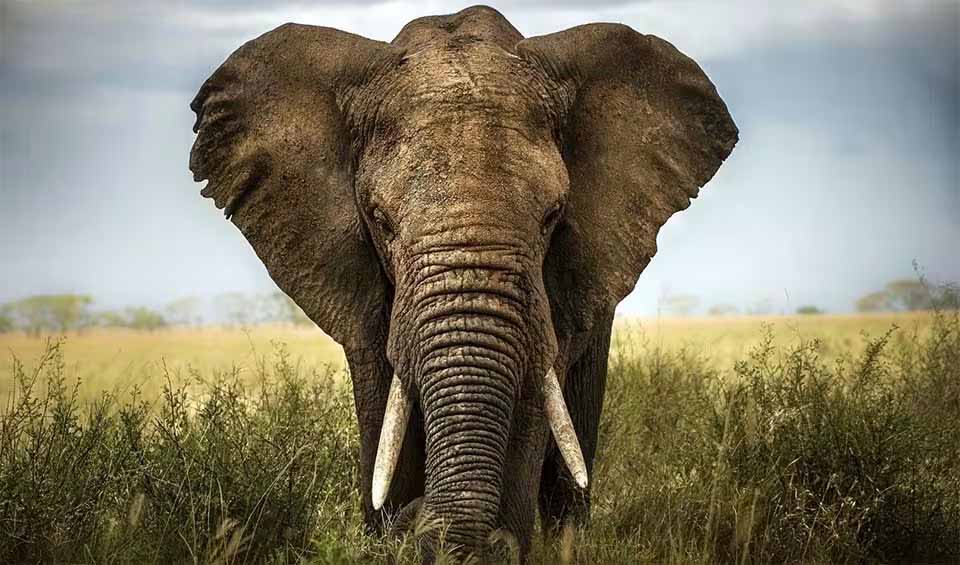A magnificent relic of the Pleistocene era that stands as the largest terrestrial animal alive today. Among the three existing elephant taxa, which also include the African forest elephant and the Asian elephant, the bush elephant is distinguished by its impressive size and iconic, large ears. These enormous ears are not merely a distinctive physical feature; they serve a crucial biological function, enabling the elephant to dissipate heat and regulate its body temperature in the scorching savannas and grasslands it calls home.
Sporting large, curved tusks present in both males and females, bush elephants are immediately recognizable and have, unfortunately, become targets for poaching due to the high value of ivory. This illicit demand for ivory has led to significant losses within elephant populations, exacerbating the challenges of their already low reproduction rates. Elephants reproduce slowly, with long gestation periods that do not sufficiently compensate for the numbers lost to poaching, pushing these gentle giants closer to the brink of endangerment.
Historically, the African bush elephant roamed across Africa, a testament to their adaptability and the vastness of their natural habitat. However, their current distribution is limited to 37 countries in Central and South Africa, confined to just 15% of their historical range. This dramatic reduction in habitat is primarily due to human activity, including deforestation, conversion of land for agriculture, and urban development, alongside the persistent threat of poaching.
Distribution
 Angola
Angola Official estimate
Official estimate
 Botswana
Botswana Official estimate
Official estimate
 Burkina Faso
Burkina Faso Official estimate
Official estimate
 Burundi
Burundi Official estimate
Official estimate
 Cameroon
Cameroon Official estimate
Official estimate
 Central Af. Rep.
Central Af. Rep. Official estimate
Official estimate
 Chad
Chad Official estimate
Official estimate
 DR Congo (Kinshasa)
DR Congo (Kinshasa) Eritrea
Eritrea Official estimate
Official estimate
 Eswatini
Eswatini Official estimate
Official estimate
 Ethiopia
Ethiopia Official estimate
Official estimate
 Kenya
Kenya Official estimate
Official estimate
 Malawi
Malawi Official estimate
Official estimate
 Mali
Mali Official estimate
Official estimate
 Mauritania
Mauritania Official estimate
Official estimate
 Mozambique
Mozambique Official estimate
Official estimate
 Namibia
Namibia Official estimate
Official estimate
 Nigeria
Nigeria Official estimate
Official estimate
 Rwanda
Rwanda Official estimate
Official estimate
 Somalia
Somalia South Africa
South Africa Official estimate
Official estimate
 South Sudan
South Sudan Official estimate
Official estimate
 Tanzania
Tanzania Official estimate
Official estimate
 Uganda
Uganda Official estimate
Official estimate
 Zambia
Zambia Official estimate
Official estimate
 Zimbabwe
Zimbabwe Official estimate
Official estimate
Recent updates
June 2024: A study in Nature Ecology and Evolution reveals that African elephants use specific vocal labels to identify each other, a form of communication previously unknown in nonhuman animals. Researchers analyzed 469 rumbles from wild savanna elephants in Kenya using machine learning and found distinct vocal identifiers instead of imitating individual calls.
April 2024: President Mokgweetsi Masisi of Botswana supports controversial policies like promoting hunting for wealthy tourists. He recently criticized Germany and Britain for considering a ban on elephant part imports, threatening to send Berlin 20,000 elephants.
March 2024: The U.S. Fish and Wildlife Service has implemented stricter trade protections for African elephants, requiring stronger proof that trading live elephants and hunting trophies benefits the species’ survival. This includes rigorous assessments of populations, habitats, and foreign conservation efforts.
2023: The government of Botswana announced that it will ban all elephant trophy hunting starting in January 2024, citing concerns about declining elephant populations and the importance of preserving these animals for future generations.
March 2023: In Gabon, a new AI-powered camera is being tested to help conserve elephant populations by sending real-time data to forest rangers and local villagers, while also detecting other animals, humans, and potential conflicts or illegal activities.
Jan 2023: Researchers in Tanzania announced the successful implementation of a new anti-poaching program that uses drones to monitor elephant populations and detect illegal activity. The program has already resulted in several successful prosecutions of poachers.
Did you know?
- Population in Central Africa has a 64% estimated decline.
- The average size of tusks has shrunk over the past 100 years, due to the slaughter of elephants for their ivory, which has made the “large tusk gene” increasingly scarce.
- Half of their population has vanished during the last 75 years, a trend that is thought to be ongoing and most likely irreversible.
- Poaching is increasing dramatically in some of the historically less-affected southern African populations (w.r.t CITES Monitoring the Illegal Killing of Elephants programme (MIKE))
- Despite an international ban on the trafficking of elephant tusk ivory, China’s thirst for “white gold/ivory” drives the poaching of over 30,000 elephants in Africa each year.
- Large quantities of elephant ivory have been utilized to create billiard balls, piano keys, identification tags, jewelry and several other products for mere human enjoyment.
- Tusks are typically enlarged canine teeth in mammals, but in elephants, they are elongated incisors. One third part of the tusk is actually embedded deep in the elephant’s head, invisible from outside. Elephants’ tusks never stop growing.
- They have the longest gestation period of any mammal i.e. 22 long months!
- More than 40,000 muscles and tendons manipulate their trunk, that’s 60 times more muscles than the human body!
Anything we've missed?
Help us improve this page by suggesting edits. Glory never dies!
Suggest an editGet to know me
Terrestrial / Aquatic
Altricial / Precocial
Polygamous / Monogamous
Dimorphic (size) / Monomorphic
Active: Diurnal / Nocturnal
Social behavior: Solitary / Pack / Herd
Diet: Carnivore / Herbivore / Omnivore / Piscivorous / Insectivore
Migratory: Yes / No
Domesticated: Yes / No
Dangerous: Yes / No
African bush elephant on banknotes










